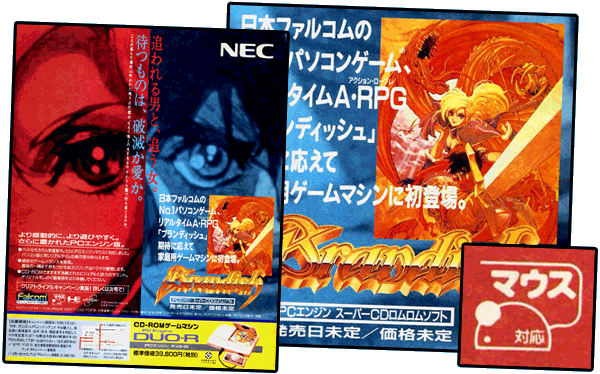Has anyone compiled a complete list of all the strategy guides published for the PC-Engine? If so, I have yet to see it. Pictured below are strategy guides for two of the greatest PCE games ever released: Ys IV–Dawn of Ys and Akumajou Dracula X–Chi No Rondo (folks outside of Japan may be more familiar with the title Castlevania–Rondo of Blood)…

CASH MONEY: Ys IV–Dawn of Ys (¥1,200). Akumajou Dracula X–Chi No Rondo (¥1,400).
NO RONDO, LITERALLY: Keen eyes will note that the subheading for Dracula X reads "Reincarnation of Blood" instead of the familiar "Rondo of Blood". Was this a simple typographic error, or was Reincarnation of Blood an alternate title? Or, perhaps Reincarnation of Blood was simply a working title used internally amongst the PCE development team at Konami?
DEMYSTIFICATION: The confusion surrounding the the title "Akumajou Dracula X–Chi No Rondo" can be explained, however. It turns out that the original Japanese title is pronounced as "reincarnation", but Konami designated "rondo" as the official pronunciation of the kanji in the subheading.
So, now we are left with one final question: which cover is aesthetically superior—the strategy guide or the PCE cover? Judge for yourself…

STRATEGY GUIDE vs. PCE COVER: Can the art, typography and layout of the strategy guide compete against those of the PCE cover?
ART CRITIC: My first impulse was to criticize the composition of the strategy guide and praise the PCE cover (indeed, I promptly wrote a lengthy paragraph analyzing the two covers). But, the more I wrote, the more I began to appreciate the strategy guide for at least attempting to create something "new" and not simply regurgitating, wholesale, existing Dracula X/Castelvania artwork. The strategy guide takes a familiar, hand-drawn image of Richter Belmont and throws him in front of a (crudely PhotoShopped) photograph of a gothic church—initially I viewed this as a poorly-executed excursion in mixed-media, but now I find it somewhat endearing. What can I say? Judge for yourself…
Continued below…
BRANDISH (SCD+ACD, MB128, PCE MOUSE)…▲
INTRIGUE #1: I have never played any of the games in the Brandish series, nor have I heard much about them. This is one of the reasons why I am intrigued by Brandish on PCE. Since I am a sucker for any ARPG by Falcom, it is only a matter of time before I get my hands on it. Furthermore, Brandish is one of the few "hybrid" SCD+ACD games that takes advantage of the extra ROM offered by the Arcade Super CD•ROM2 (ACD) format. If the console detects the ACD System Card inserted in the HuCARD slot, data for several cinema scenes are buffered en masse, thereby allowing the cinemas to play continuously with fewer, if any, pauses (to load additional data).

INTRIGUE #2: MB128 was a niche product that solves a very specific problem presented by only a handful of games in PCE's vast library of titles. It is a small, rectangular, battery-powered peripheral that plugs into the controller port. A control pad, in turn, is plugged directly into the mini-DIN port provided by MB128 itself.
The MB128 was a "memory bank" supported by a handful of late-era PCE SCD/ACD games. It was an alternative method for saving game progress. Normally, game progress was saved internally within the PCE console, a method that worked well with most games. A few select games, however, generated files large enough to fill most, if not all, of the internal memory alloted for game saves. The MB128, then, was especially convenient for the handful of games that generated huge save files.
INTRIGUE #3: Apparently, Brandish, which originally appeared on NEC's PC-98, was a very mouse-centric game. If so, then it is not surprising that the PCE version, which appeared late in the console's life, supported the PCE Mouse.
I freely admit that I have been intrigued with software that supports the PCE Mouse. My driving question has been, "When has the PCE Mouse been used to its fullest potential?" This goes beyond simple things (such as, "Is the mouse responsive?") and delves into deeper questions (such as, "Was the game's user-interface designed with the mouse in mind? How did developers balance the needs of a mouse-centric vs. controlpad-centric design?").
The PCE Mouse was a niche product. As such, the developers knew that most people would be using a standard control pad when playing Brandish. How did the developers handle these competing priorities?
▲
Return to top of page…